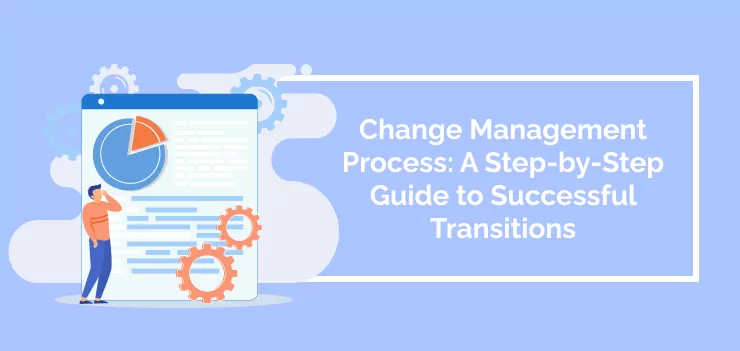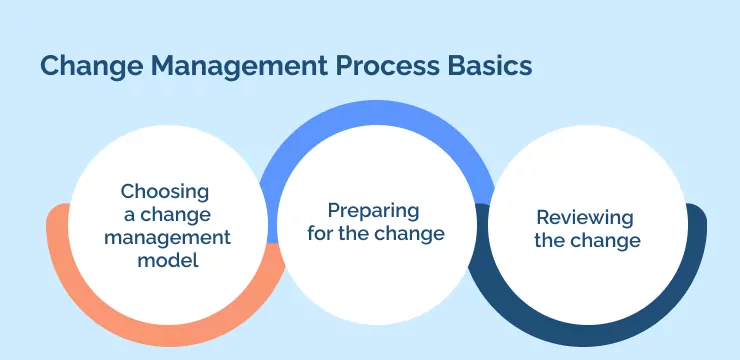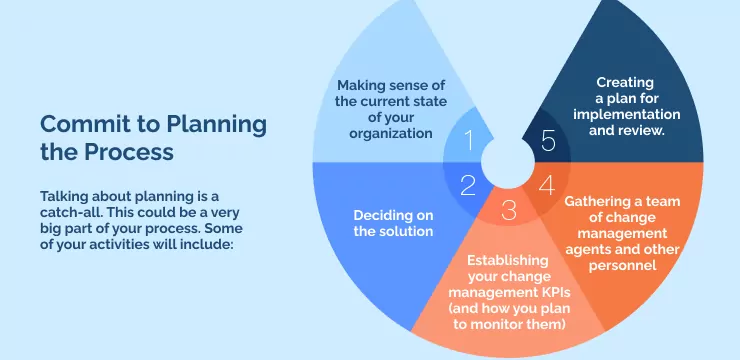
This is a quick introduction to the change management process. If you’re starting to think about organizational development, there’s a chance you’re feeling nervous about it.
Change itself is not always a deliberate process. Change can happen by mistake. It can be an accident. Change does not always happen according to a plan. By contrast, change management is a process. As soon as you try to manage the change, you must think about your steps.
This article will take you through the basics of the change management process.
We will briefly define the change management process and explain why it’s so important to use a clear process. (Clue: you don’t want your project to fail!). We will then show you some of the most important steps for your change process: through change models, preparation, and evaluation.
Getting started with change projects is daunting. But once you read this article, you’ll see how to break down the process and make change management happen.
What is the change management process?
It’s confusing that change management is full of different words and phrases with lots of words and definitions. Roles, implementation, frameworks, strategies – and much more besides!
When we talk about the change management process, we’re thinking about the full story of change management. That includes:
- The first conversations about problems
- Discovery of solutions
- Investigation of change models, theories, and frameworks
- Preparations to implement the change
- Reviewing, monitoring, and adapting the outcome
So, the change management process is not the same as a change management model, a change management framework, a change management theory, or change management principles.
Why do you need a change management process?

Good luck if you want to make a change without a change management process! Maybe it will work out. Maybe it won’t. You will have no way to ensure success.
Change management research shows that even planned change projects can easily collapse (even if the 70% failure rate is exaggerated). The situation for unplanned change projects will be even worse.
More specifically, some of the problems you might encounter include:
- Inappropriate change solutions
- Confusion amongst staff at all levels
- Unpredictable barriers to change
- Budget overspend
- Adverse impact on many operations
You might neglect your change management process because of the following:
- Maverick leadership
- Misunderstanding the scale or complexity of the change
- Mis-placed confidence
- Insufficient resources
- Pressure from senior stakeholders to act quickly.
For any of these reasons, you might think a proper change management process is unnecessary. You can imagine the ways that careless leaders could respond: “It’s no big deal!”, “It won’t take long!”.
For junior managers, answering these comments is very difficult. But make no mistake: you’re taking a very high risk without a proper change management process.
Change Management Process Basics

So – what are some of the basics for change management?
In this section, we will introduce three key areas of the change management process. These are:
- Choosing a change management model
- Preparing for the change
- Reviewing the change
Right now, we won’t talk about implementation, communication, or building consensus in your organization. But by focussing on your change model, the preparation, and the review, you’ve got the basics of a proper change project.
Find a Model for the Change Management Process
Your first step is to get educated. A change management model will guide you through the process.
For the classic model of change, look at Kurt Lewin’s three-stage approach. Lewin first wrote about this in the 1930s, and much of his wisdom holds true today. Check out the McKinsey 7s, the Lippitt-Knoster model, or Prosci’s ADKAR approach for more current models.
Do your research early in your project, and you’ve got a great opportunity to debate, explain, and understand the key issues in your change project.
Commit to Planning the Process

Talking about planning is a catch-all. This could be a very big part of your process. Some of your activities will include:
- Making sense of the current state of your organization
- Deciding on the solution
- Establishing your change management KPIs (and how you plan to monitor them)
- Gathering a team of change management agents and other personnel
- Creating a plan for implementation and review.
The exact preparation process will depend on your change management model, and many other things besides.
Get Ready to Review the Change Process Outcomes
How will you know if your change project is a success or not?
Measuring change is the final part of the change management process, but it’s as important as every other step.
You will use the KPIs, baselines, and benchmarks you chose in the planning stage.
With qualitative and quantitative data analysis, you will find out if the change project has succeeded. Has staff behavior changed? Are you achieving a good ROI on the project? How could the implementation be improved?
The evaluation phase is important for several reasons. It tells you how effective one specific project is. It may give you a general sense of your organization’s adaptability. And most importantly, it gives you vital data to share with key stakeholders.
The Change Management Process: Get It Right Reap The Rewards
So there’s your quick-and-dirty introduction to the change management process.

According to KPMG, 37% of executives underestimate the impact of change projects on their organizational infrastructure. It’s great that a majority do understand the importance of the change management process. But it’s still worrying that so many people don’t think about change enough.
By now, you know that you don’t want to be in that 37%. If you want to make a positive difference, just remember to take our advice. First, remember that a change management process is a high-impact activity. Change won’t just happen by itself: you need a whole process. There are many ways that a change project can fail, and you should avoid these at all costs.
The three most fundamental parts of the change management process are finding the right change model for you, planning effectively, and evaluating comprehensively.
You’ve taken the first step towards a positive change project. Work hard at every stage, and you’ll find a change management process flow that works for your organization.
WalkMe Team
WalkMe spearheaded the Digital Adoption Platform (DAP) for associations to use the maximum capacity of their advanced resources. Utilizing man-made consciousness, AI, and context-oriented direction, WalkMe adds a powerful UI layer to raise the computerized proficiency, everything being equal.



